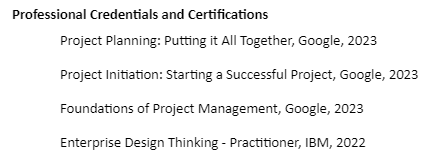
A micro-credential recognizes and verifies that a learner has by successfully demonstrated competence of a skill or set of skills via authentic assessment. The authentic assessment typically consists of implementing the new skill in a workplace setting and showing evidence of the implementation. Our blog post, The Relationship Between Digital Badges and Micro-credentials states, “micro-credentials use the representation of a digital badge to provide details about the learning experience.” The digital badge provides details about the learning experience such as micro-credential name, description, criteria, issuer, assessment, resources, evidence, and date issued.
Digital Promise offers micro-credentials that are competency-based, research-backed, personalized, and on-demand. Digital Promise’s Micro-credential Framework consists of Key Method, Method Components, Supporting Research and Rationale, Resources, Submission and Evaluation, and Assessors’ Feedback. Two examples of micro-credential issuers are Childhood Education International and International Baccalaureate.
In Childhood Education International’s Social and Emotional Learning and Psychosocial Support for Quality and Holistic Learning Micro-credential, the learner (an educator) recognizes the role of social and emotional learning (SEL) and psychosocial support (PSS) in their classroom and can adapt existing SEL/PSS tools to meet the unique needs of their learners and their educational context.

In International Baccalaureate’s Design an Analytic Rubric for Formative Assessment in Collaboration with Students Micro-credential, the learner (an educator) designs an analytic rubric for formative assessment in collaboration with students.
Through earning a micro-credential, learners are able to quickly learn and implement new skills to reskill and upskill. A micro-credential provides the learner with learning opportunities to build on their expertise or expand into a new area of interest. It can lead to licensure, recertification, salary bumps, or bonuses. Micro-credentials are “inclusive learning opportunities to meet society’s current and future challenges” (Bozkurt & Brown, 2022, p.2). Micro-credentials provide affordability, flexibility, and personalization compared to macro-credentials like degrees. In comparison to micro-credentials, pursuing a degree is more timely and costly, and less specific. Micro-credentials are closing the gap as they are favored by historically and systematically excluded learners who find it challenging to commit to the financial and time requirements of higher education pathways.
Micro-credentials “attest to specific learning outcomes that might be lost in a degree or degree transcript,” making the educational experience more relevant and efficient (Milligan & Kennedy, 2017). This unbundling of higher education pathways into micro-units of learning creates granular accomplishments that are motivational and encouraging to learners (Pirkkalainen et. al, 2022). Hence, earning a micro-credential is a valuable opportunity for learning and professional growth.
Having earned a micro-credential is a career accomplishment and can be included on a resume or shared on online platforms like LinkedIn. This allows current and potential employers to view the learner’s complete picture of skills or competencies they have, and what they bring to the organization. The employer is able to view and understand the micro-credentials’ requirements, the assessment completed, and the evidence submitted.
Following the standard resume format, micro-credentials can be listed by date earned in either the Licenses and Certificates section or the Education section. Including information about the micro-credential like the issuer’s information and title is essential.

Resume Example

LinkedIn Example
Earning a micro-credential is an asset to an individual’s learning journey. Micro-credentials “play a key role in displaying specific marketable skill sets to employers” (Janckenko & Rodi, 2019, p.22). They help bridge gaps in an individual’s learning journey, verifying the attainment of specific skills or set of skills they need to be successful. Micro-credentials help learners who have higher education degrees, as well as those who do not. Earning a micro-credential shows that the individual is learning and improving themselves professionally.
A number of different educational institutions, companies, and organizations offer micro-credentials. A prospective earner should consider and review who the issuer is, paying attention to what the micro-credential entails and what past earners have to say. Typically, micro-credentials associated with a higher education institution are better vetted than ones without an affiliation (Post University, 2022).
Displaying micro-credentials on a resume or LinkedIn allows a prospective employer to view the complete picture of the learner. A learner can use micro-credentials to demonstrate attainment of skills they need to upskill or reskill, which allows them to close the gap between their existing certificates, diplomas, and degrees, as well as expand to new areas. Because micro-credentials recognize micro-units of learning, the array of options encourages lifelong learning.
Do you have a great story of how micro-credentials have supported your personal goals? Please contact us to learn how you can share your story. If you are interested in learning more about micro-credentials, check out our current offerings on the Micro-credential Platform or sign up for our quarterly newsletter to stay updated on micro-credentials.
Bozkurt, A. & Brown, M. (2022). Micro-credentials: Stackable, combinable, or transferable qualifications. EdTechnica: The Open Encyclopedia of Educational Technology. http://eprints.rclis.org/43714/.
Galindo, M. (2023). The Relationship Between Digital Badges and Micro-credentials. https://digitalpromise.org/2023/04/13/the-relationship-between-digital-badges-and-micro-credentials/
Janckenko, G., & Rodi, A. (2019). Using digital badges to promote professional development in higher education. Issues in Information Systems, 20(4). 21-26.
Milligan, S. & Kennedy, G. (2017). To what degree? Alternative micro-credentialing in a digital age. In James, R., French, S. & Kelly, P. (Eds.) Visions for the Future of Australian Tertiary Education (1 ed., pp. 41-54) Centre for the Study of Higher Education, University of Melbourne.
Pirkkalainen, H., Sood, I., Padron Napoles, C., Kukkonen, A., & Camilleri, A. (2022). How might micro-credentials influence institutions and empower learners in higher education? Educational Research, 65(1). 40-63.
Post University. (2022). Badges and micro-credentials – What’s the difference? https://post.edu/blog/badges-and-microcredentials-whats-the-difference/